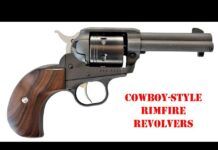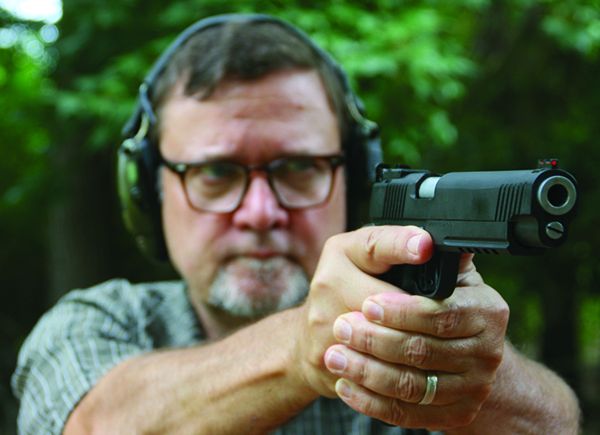The 10mm Auto is a powerful cartridge. When the 10mm is loaded to its full potential, it produces magnum-caliber revolver energy, and depending on the bullet and velocity, it can best the typical 357 Magnum load and come in just below the typical 41 Magnum load. That’s hot. It’s a powerful and effective round, especially in a semi-automatic.
The hapless Bren Ten was the first semi-automatic pistol to be chambered in the round back in 1983 by Dornaus & Dixon Enterprises. The second gun to be chambered in the round was the Colt Delta Elite in 1987. The 1911 platform is strong, and after a few fits and starts early on with cracked frames, Colt was able to adapt the 1911 platform to the cartridge. Part of the problem with the 10mm Auto is the pressure, which is about 37,5000 psi. The 357 Magnum has a pressure of about 35,000 psi, and the 41 Magnum has 36,000 psi. The pressure literally wants to destroy guns. Since the 1980s, other manufacturers have introduced 10mm striker-fire pistols, handguns based on the CZ-75 design, DA/SA models from Smith & Wesson, and other 1911 models. We wanted to take a look at the 1911 platform in this hot round, so we procured three 1911s chambered in 10mm Auto — a Springfield Armory (SA) Ronin, Kimber Rapide Black Ice, and Rock Island Armory Pro Match Ultra 6″.
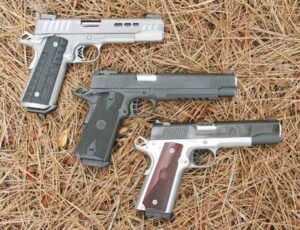
Factory 1911s can have quite a bit of variation from pistol to pistol in trigger feel and quality, as well as slide-to-frame fit, and the blending of the thumb safety and grip safety. Typically, the lower the cost, the less workmanship that goes into the 1911. Remember, a 1911 needs to be hand built and fitted. It is not like today’s striker-fire guns that are easily assembled. The hand-fitting is also why some 1911s are finicky about ammo and running smoothly.
All three of these 1911s are very similar. It’s the details that separate them. The SA and Kimber feature 5-inch barrels, and the Rock Island Armory (RIA) does them one better with a 6-inch tube. The RIA and SA have thinner grips and no magazine well, while the Kimber grip is thick, and it has a magwell for smoother reloads. Another common feature are highly visible and usable sights. The RIA goes a step further with a fully adjustable rear sight, while the Kimber and SA have driftable rear sights.
How We Tested
We did experience a failure to eject and a failure to slide lock back on the Kimber, but that was with the first magazine. From then on, no issues. The RIA also experienced an initial failure to lock the slide back. We attribute these issues to needed break in. After those minor hiccups, the pistols ran flawlessly. The Springfield ran flawlessly from the get go.
We averaged 1- to 1.5-inch five-shot groups at 15 yards across all three pistols. There is a reason why many shooters like the 1911 platform’s single-action trigger. With all of these pistols, we were able to shoot our best groups under 1 inch using a rest. In many instances, holes overlapped each other. With more range time, we are certain we could easily tighten the groups with any of these guns.
Ammo used during testing consisted of Federal Premium HST 200-grain JHP defense rounds and two training rounds; Magtech and Armscor loads with 180-grain FMJ bullets. All three of these loads cranked out of the muzzle doing a respectable 1100 fps, on average. This is powerful ammo, and when we tabulated the data, we found it accurate as well. Using a rest, we fired at Thompson Trouble Shooter targets set at 15 yards. All three pistols showed good to excellent accuracy. The RIA was exceptionally accurate, with many tight groups showing touching bullet holes.
Recoil was stout, so don’t think a 10mm Auto is for the faint of heart or recoil shy. The Kimber and RIA have front grip strap texture that helps with grip control. This additional texture helps to prevent grip slippage from recoil when the gun is fired. These guns did a good job of recoil management, and the RIA offered faster follow-up shots due to the extra weight.

We tested the guns’ fast-shooting qualities at 15 yards using a plain 8.5-by-11-inch white piece of paper with a 2-inch black square printed in the middle. We fired fast, at the edge of control, and we were able to keep rounds on target. We needed to lean into the pistol because recoil is fast and snappy, and it can get away from you if you are not paying attention. You don’t want to shoot a 10mm fast standing on your heels. We stood on the balls of our feet with knees slightly bent. Most fast-shooting groups we could cover with our hand. We also noticed the web of our hand was getting a workout. No abrasion from any of the guns, but we did notice some grips were more comfortable, namely the SA and the RIA. The Kimber grips have a high cool factor and were comfortable, but not as comfortable as the grips on the other two guns. Some of our testers grip a 1911 and ride the controls, meaning a right-handed shooter will rest the shooting-hand thumb on the thumb safety and the thumb of the support hand on the slide stop. Those with average to small hands noticed the larger grip circumference of the Kimber compared to the SA and RIA, and in some cases needed to change their grip for better trigger control. We also swapped magazines between guns to see if we could trip up any of them. We had no feeding issues.
That’s the high-level view of these 10mm pistols, now let’s get into the weeds.
Gun Tests Grade: A-
$1199
We’ve tested other RIA 10mm 1911 pistols in the past and gave them good grades. We had high expectations with the Pro Match Ultra 6″, and it delivered on those expectations. This is a pistol designed for action-pistol shooting competition or hunting. We’d love to take the RIA boar hunting.
| Action | Semi-auto, locked breech single action |
| Overall Length | 9.7 in. |
| Overall Height | 5.5 in. |
| Maximum Width | 1.3 in. |
| Weight Unloaded | 48.3 oz. |
| Weight Loaded | 54.9 oz. |
| Barrel | 6.0 in. |
| Capacity | 8+1 (single stack) |
| Slide | Parkerized steel |
| Slide Retraction Effort | 22.0 lbs. |
| Frame | Parkerized steel |
| Frame Front Strap Height | 2.5 in. |
| Frame Back Strap Height | 3.2 in. |
| Grips | Checkered double diamond rubber |
| Grip Thickness (max) | 1.2 in. |
| Grip Circumference (max) | 5.3 in. |
| Front Sight | Dovetail fiber optic |
| Rear Sight | Adjustable |
| Trigger Pull Weight SA | 7.0 lbs. |
| Trigger Span Single Action | 2.8 in. |
| Magazines | 2; steel w/bumper pad |
| Safeties | Ambidextrous thumb, beavertail grip |
| Warranty | Limited lifetime |
| Made In | Philippines |
| Website | Armscor.com |
At 48.3 ounces unloaded, the RIA is a handful. It is muzzle heavy due to the extended dustcover and Picatinny rail. The added heft of the rail, barrel, and slide, however, helps in recoil management.
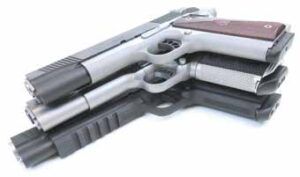
The RIA comes decked out in most of the competition features you’d expect: extended beavertail safety grip, ambidextrous thumb safety, comfortable grips, Delta-style hammer, skeletonized trigger with adjustable trigger stop, two-piece recoil rod for smooth operation and improved accuracy, and fiber-optic front sight and adjustable rear sight. The only feature missing is a magazine well. If we could, we’d trade off the ambidextrous thumb safety for a flared magazine well. That’s our right-handed shooter bias speaking. The gun comes in a hard case with two steel magazines with polymer bump pads.
The RIA does not use a traditional barrel bushing, but instead employs a flared barrel that mates to the inside of the slide. The heavy bull barrel is not ramped. To accommodate the extra barrel length, the RIA uses a two-piece guide rod. There is no traditional barrel bushing, so takedown is different. The end of the guide rod is slotted to accept a screwdriver blade, and you unscrew the guide rod until it can be removed from the slide. This procedure makes disassembly more complicated. There was no wiggle between the barrel and slide, but we felt very slight movement between the slide and frame. We thought this 1911 was built well.
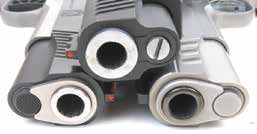
The slide has the traditional dome shape and medium serrations both front and rear. They provided good traction when racking the slide. It took more effort — 22 pounds — to rack the slide. The rear sight is click-adjustable for windage and elevation, and it uses a generously-sized notch for ease of use. The shooter-facing side is also serrated to reduce sun glare. The top corners of the rear sight are also chamfered so your eye focuses on the notch and not on the edges of the sight. Up front, the sight is a red fiber-optic pipe. It is dovetailed into the slide and can be drifted left or right for additional windage adjustments.
The RIA wears a rather plain but well-executed Parkerized finish, giving the long slide an all-business look. The thin grips were made of rubber with a double-diamond checkered texture. The grips provided a soft stickiness that was well suited for the snappy recoil of the 10mm. The serrated front grip strap also aids in recoil management.
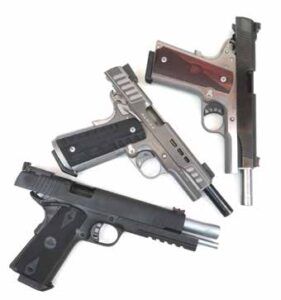
The trigger-pull weight measured an even 7 pounds, which was too much for a competition gun. Even with that handicap, we shot the RIA best out of all the 1911s. The trigger face was serrated. Our best five-shot group measured 0.6 inches with the Federal Premium HST 200-grain JHP defense ammo. The best group with training ammo measured 0.7 inches using Armscor 180-grain FMJs. Nice shooting. The Magtech 180-grain FMJs had a best group of 1.1 inches. The skeletonized trigger also can be adjusted for trigger stop.
Where the RIA really showed its stuff was in speed shooting. The heft of the pistol helped us stay on target with better recoil management. We did have one issue in the first magazine of the slide not locking back, but thereafter it ran flawlessly. We attribute the failure to a needed break-in period.
The thumb safety and grip safety were nicely blended and smooth, so recoil in the web of our hands was tolerable, and dare we say, pleasant. There was also plenty of bump on the grip safety to adequately depress it. The thumb safety worked with precise clicks and was easy to operate with our shooting-hand thumb.
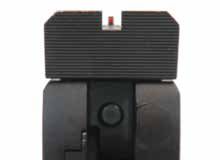
During reloads, we operated the long slide using two methods: manipulating the slide stop and sling-shotting the slide. The slide stop was easy to operate and offered less movement than the sling-shot method. Also, the rear sight has edges and can tear the palm of your hand if you rack it too fast and furious. The magazine button is checkered, providing plenty of friction for positive mag ejection.
We did see a slight bit of added velocity and energy with the longer barrel using some rounds; it was anywhere from 4 to 19 fps more with the long slide. The advantages with the longer barrel/slide is a modest increase in velocity/energy, sight radius, and heft for recoil management.
Our Team Said: The RIA offers a lot of competition-ready features, but more important, it delivers performance. We would happily hunt whitetail deer or pigs with this long-slide pistol.
10mm Auto Range Data
| Magtech 180-grain FMJ | Rock Island Armory Pro Match Ultra 6" | Kimber Rapide Black Ice | Springfield-Armory 1911 Ronin |
| Average Velocity | 1199 fps | 1165 fps | 1180 fps |
| Muzzle Energy | 575 ft.-lbs. | 543 ft.-lbs. | 567 ft.-lbs. |
| Smallest Group | 1.1 in. | 0.7 in. | 1.5 in. |
| Average Group | 1.2 in. | 0.9 in. | 1.6 in. |
| Federal Premium HST 200-grain JHP | Rock Island Armory Pro Match Ultra 6" | Kimber Rapide Black Ice | Springfield-Armory 1911 Ronin |
| Average Velocity | 1132 fps | 1130 fps | 1144 fps |
| Muzzle Energy | 569 ft.-lbs. | 567 ft.-lbs. | 581 ft.-lbs. |
| Smallest Group | 0.6 in. | 0.8 in. | 0.8 in. |
| Average Group | 0.8 in. | 1.3 in. | 1.1 in. |
| Armscor 180-grain FMJ | Rock Island Armory Pro Match Ultra 6" | Kimber Rapide Black Ice | Springfield-Armory 1911 Ronin |
| Average Velocity | 1117 fps | 1088 fps | 1113 fps |
| Muzzle Energy | 499 ft.-lbs. | 473 ft.-lbs. | 496 ft.-lbs. |
| Smallest Group | 0.7 in. | 1.2 in. | 0.9 in. |
| Average Group | 0.8 in. | 1.3 in. | 1.1 in. |
| Gun Name | Issue | Grade | Comments |
|---|---|---|---|
| Smith & Wesson M&P40 M2.0 11522 40 S&W, $581 | Oct. 2021 | A | Best Buy. The 18-degree grip angle made the M&P M2.0 feel natural. The trigger was very consistent. |
| Glock G23 Gen5 PA235S203 40 S&W, $700 | Oct. 2021 | A | Recoil management was excellent. We like the flared magwell, front slide serrations, and improved trigger pull. |
| Heckler & Koch P30S-V3 81000127 40 S&W, $859 | Oct. 2021 | A- | The P30 is the benchmark for a DA/SA-style pistol with an excellent grip and sights and good accuracy. |
| SIG Sauer P239 23940BSS 40 S&W, $600 | Oct. 2021 | A- | Recoil was controllable and accuracy was good. Design felt dated, but we’d consider buying a used P239. |
| Springfield Armory XD-M 5.25 10mm Auto, $681 | Sept. 2020 | A- | Best Buy. To take backpacking in the boonies, the XD-M and its 16-round payload might well be our choice. |
| Colt Delta Elite 02020RG 10mm Auto, $1134 | Sept. 2020 | A- | When we were firing the Buffalo Bore stompers, we were just fine with the Colt’s smooth front strap. |
| SIG Sauer Tacops 10mm Auto 1911R-10-TACOPS, $1050 | Sept. 2020 | B/A- | Had extraction issues initially. SIG fixed the problem fast, so we upgraded its marks to include customer service. |
| Lone Wolf TWL-S Frame/Gray Man Slide 10mm, $884 | Aug. 2020 | A | The Grey Man G20 is a handful. The small grip made this pistol easier to conceal. Trigger was excellent. |
| Springfield XD-S 3.3-Inch XDS93340BE 40 S&W, $378 | Sept. 2019 | A | Best Buy. Completely reliable, accurate enough for personal defense. Useful trigger action and good sights. |
| Kahr CW40 CW4043 40 S&W, $301 | Sept. 2019 | B | A well-made and reliable handgun, despite a number of corners being cut to offer the pistol at a low price. |
| SIG Sauer P224 SAS 224-40-SAS2B 40 S&W, $800 | Sept. 2019 | B | A compact pistol with a short barrel and grip that takes some getting used to, yet excellent accuracy. |
| Taurus G2C 1-G2C4031-10O 40 S&W, $250 | Sept. 2019 | B | An upgrade over the original, with superior grip treatment and a new matte-finished slide. |
| Smith & Wesson Shield 180020 40 S&W, $337 | Sept. 2019 | D/D | We tested two Shields, one with a safety and one without. The 180020 with safety short-cycled. The 10034 non-safety Shield had a failing trigger return spring that caused a stoppage. |
| Glock G40 Gen4 MOS 10mm Auto, $706 | Mar. 2019 | A | Longer sight radius and ability to mount a red-dot optic made the G40 a close contender for top dog in the test. |
| Springfield 1911 RO Elite Operator 10mm Auto, $1145 | Mar. 2019 | A | Well adapted for the 10mm cartridge. We like the sights and love the trigger. Grip texture is a bit raspy. |
| Springfield Armory XDM 10mm Auto, $779 | Mar. 2019 | A | Best Buy. Great ergonomics, nice grip angle, modular grip strap, crisp trigger, nice sights. Reasonable cost. |
| Glock G35 Gen3 PI3530103 40 S&W, $560 | Jul. 2017 | A | The G35 in 40 S&W is a good competition pistol. A 9mm barrel makes it more affordable to shoot. |
| Smith & Wesson Model 1076 10mm Auto, $800-$825 | Nov. 2017 | A- | As a compact 10mm, a used 1076 is an excellent choice. Trigger could have been better. |
| Colt Delta Elite O2020XE 10mm Auto, $1099 | Nov. 2017 | A | The latest Delta Elite is an excellent full-size 1911 chambered in 10mm. We liked the trigger, sights, grip. |
| EAA Tanfoglio Witness 10mm Auto, $665 | May. 2017 | A | Best Buy. Relatively compact and accurate, plus it is affordable. |


